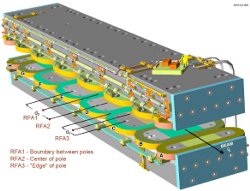 |
 |
|||||||||||||
|
|||||||||||||
|
|||||||||||||
|
When you have a set of new hardware and a clear mission ahead of you, the first step to complete the mission is to commission the hardware. After reconfiguring their storage ring and light source CESR, Cornell University and the international ILC team working on damping ring studies switched on the machine in early October and performed the first electron cloud studies in the low emittance configuration in November. “It was an intense week and we have some very interesting new data,” says Mark Palmer, CesrTA project manager. The goal of these tests is to find out how to create a beam that is so focused, small and uniform that it delivers the high rate of collisions needed for the ILC. For a beam of such high quality, there is lots of potential for harm along its future racetrack: destabilising electron clouds can form, and the beam can disperse or veer off track. At Cornell, scientists are looking at ways to avoid the electron cloud build-up and the resulting emittance dilution and instabilities that the cloud can cause. They are also investigating ways to best provide ultra low emittance bunches in the damping ring for transfer to the main accelerator. These are all central R&D studies for the ILC's Technical Design Phase. Since the conclusion of the colliding beam physics program at CESR early in the spring, the ring has undergone a major reconfiguration. Changes include the removal of the CLEO interaction region and the relocation of several wigglers to convert CESR into a low-emittance damping ring. Diagnostics to monitor the beam and the electron cloud in the vacuum chambers were newly installed or upgraded. The new diagnostics include retarding field analysers (RFAs) in the vacuum chambers within the wigglers, a tool developed especially to monitor and understand electron cloud formation. “We also continued our upgrade of the fast feedback system to maintain beam stability with short bunch separation, improved the survey and alignment systems, and continued preparations for installation of a high-performance BPM system, so that we can tune CesrTA for ultra-low emittance,” explains Palmer. Finally, an existing X-ray beam line was modified to house the optics and pixel detector for a fast, high-resolution X-ray beam size monitor.
During the commissioning run, one important result was the first set of measurements of the energy spectra of the electron cloud striking the walls in the instrumented wiggler vacuum chambers. These measurements served to validate the operation of the newly installed RFAs and are presently being compared with earlier simulations so that the detailed characterisation of the electron cloud growth in the wiggler chambers can begin. A more systematic study of the cloud growth in one titanium nitride-coated and one uncoated copper wiggler vacuum chamber will be carried out during the next CesrTA run in January. Other commissioning work included establishing injection conditions and storing beam in the new high-tune, low-emittance CesrTA optics, commissioning of the new X-ray beam line, initial characterisation of the indium gallium arsenide photodiode detector arrays that are candidates for use in the final X-ray beam size monitor, the development of new injection tools for operating with ILC-like bunch trains, and a host of other instrumentation and feedback checks. While they are continuing to align the ring and optimise the magnet setup for the lowest emittance possible, they are looking at the first data from the electron cloud experiments and will discuss a prioritised plan for future electron cloud studies. Before the next test run in January they also plan to install new, higher resolution optics, for the X-ray beam size monitor. -- Barbara Warmbein
|
|||||||||||||
| © International Linear Collider |


